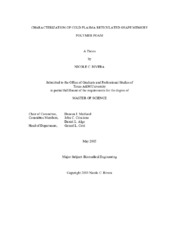| dc.description.abstract | Reticulation, the process of opening and removing cell membranes from shape memory polymer (SMP) foam, is an important processing technique to improve the permeability of SMP foam for utilization in several biomedical applications. Embolization biomedical applications, such as in the prevention of type II endoleaks (EII) associated with abdominal aortic aneurysms (AAAs), require specific reticulation levels for enhanced cell infiltration and thrombosis upon foam implantation. While several techniques have been employed to reticulate polyurethane SMP foam, reticulation of ultra-low density polyurethane SMP foam (ρapp < 0.02 g/cm3) using these techniques has been mostly ineffective. The focus of this work was to investigate the use of cold plasma treatment as a technique for controlled reticulation of ultra-low density polyurethane SMP foam for EII prevention.
Four plasma processes were developed to accomplish moderate (60-80%) and complete (>95%) reticulation of two SMP foam geometries, blocks and sheets. After the plasma processes were developed, the percent reticulation (Pret) achieved by each plasma process was quantified to show that the processes satisfied the moderate and complete Pret requirements. The Pret homogeneity throughout the foam blocks was measured by calculating the percent sample volume with complete membrane removal. These results suggested that the moderate reticulation process for the foam blocks was inhomogeneous while the completely reticulated blocks exhibited complete membrane removal throughout >98% of the sample volume.
Material characterization was performed on as-made and plasma reticulated SMP foam to evaluate the effect of plasma reticulation on the material properties. Overall, plasma reticulation decreased foam apparent density, increased permeability, decreased form factor, had mixed effects on volume expansion, and did not change wet Tg. The asmade and plasma-reticulated sheet samples exhibited reduced mechanical integrity after cleaning. The results of this thesis indicate that cold plasma reticulation is a viable technique for achieving controlled reticulation of ultra-low density polyurethane SMP foam. However, further studies must be conducted to optimize the control over Pret achieved via plasma reticulation and expand the utility of plasma reticulation to different foam geometries. | en |


